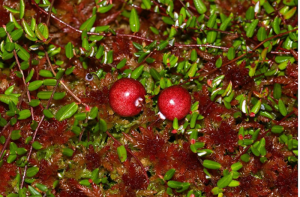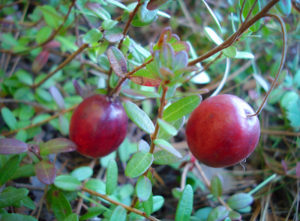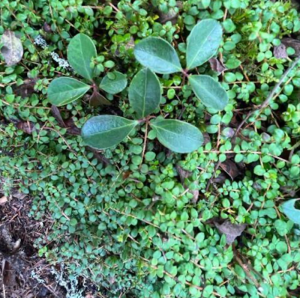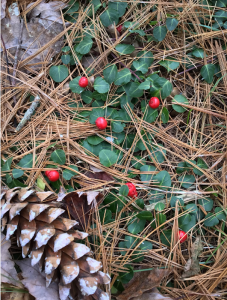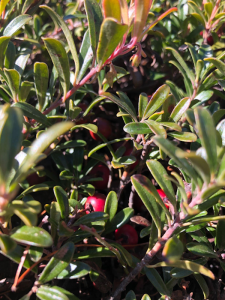
Maine Home Garden News — December 2023
In This Issue:
- Confusing Fall Berries!
- Send Holiday Cheer, Not Pests: Follow Out-Of-State Plant Health Regulations
- Celebrating Collaboration and a Bright Future: The Journey of the Joyce Hedlund Community Garden at Eastern Maine Community College
- Backyard Bird of the Month – American Robin
- Gifts for the Gardener
- Maine Weather and Climate Overview (December)
- Special Thanks!
Confusing Fall Berries!
Similar to the “Confusing Fall Warblers” section of Birds of Eastern and Central North America by Roger Tory Peterson
By Naomi Jacobs, Penobscot County Master Gardener Volunteer, and Charles Armstrong, Cranberry Professional and Staff Entomologist / Insect Diagnostician
On autumn hikes around Maine, we admire the red berries of low-growing native plants like cranberries, lingonberries, wintergreen, partridgeberry, and bearberry. But it can be tough to know just what we are seeing (and whether we can eat the berries) since the plants look so similar.
Charles Armstrong, Cranberry Professional with the University of Maine Cooperative Extension, offers these identification tips:
- Plants of the Vaccinium genus comprise roughly 450 species globally. Blueberries, cranberries, and lingonberries belong to this group. Cranberries and lingonberries are discernible in part by having many uprights arising from horizontal stems. The uprights give rise to the flowers and berries. The tart berries can be eaten raw but most prefer them sweetened. Native peoples preserved them in pemmican.
- Vaccinium oxycoccos (Swamp Cranberry or Small Cranberry) has lance-shaped leaves that are pointy at the tips. It grows in poor, acid soils and boggy conditions in far northern climes of the globe, including New England.
- Vaccinium macrocarpon (American Cranberry or Large Cranberry) has leaves that are more rounded on the ends. Like V. oxycoccus it grows in wet, acidic conditions in mostly northern regions. This cranberry is native only to North America and is the one used in commercial cultivation for juice and preserves.
- Vaccinium vitis-idaea (Lingonberry, Mountain Cranberry): Most people refer to this plant as “Lingonberry” and it grows wild all over Maine, especially in rocky conditions on the coast and mountains. The leaves are more waxy, thicker, and a bit larger than others in this group, and its red berries are rather small. Lingonberry is cultivated as a delicacy in northern and central Europe.
- Gaultheria hispidula and Gaultheria procumbens (American Wintergreen, Teaberry): Wintergreen berries are used for teas and extracts. Though the plant grows in acidic woodlands it needs sun to fruit well. Its leaves smell and taste like wintergreen. G. hispidula has a spreading/creeping growth habit with few or no vertical uprights while G. procumbens typically has 2-5 broad leaves on 2-6” upright stems arising from a horizontal underground stem.
- Mitchella repens (Partridgeberry) is in the madder family. It is easily confused with Gaultheria but lacks the minty smell and flavor. Mitchella grows in shady, acidic woodlands. Its long vine-like runners creep or spread in a horizontal fashion, without vertical uprights. The small, glossy leaves have a prominent white midvein. The berries are edible but very bland and not at all juicy. Indigenous women used a Partridgeberry tea as an aid in childbirth.
- Arctostaphylos uva-ursi (Kinnikinnick or Red Bearberry) is an incredibly rugged evergreen common to dry, exposed mountaintops and Maine’s granite coast. The red berries on this plant persist well through the winter tucked in among the leathery paddle-shaped foliage.
- Vaccinium oxycoccos; photo by: Christian Fischer, commons.wikimedia.org
- Vaccinium macrocarpon; photo by Charles Armstrong
- Vaccinium vitis-idaea; photo by Jonas Bergsten
- Gaultheria hispidula (small leaves) and Gaultheria procumbens (large leaves); photo by Wanda Greatorex
- Mitchella repens; photo by Charles Armstrong
- Arctostaphylos uva-ursi; photo by Kate Garland
To sum up:
The plant is likely a cranberry, lingonberry, or similar Vaccinium relative if seen in a boggy area or on the coast at exposed higher elevations, and if it has vertical uprights with waxy leaves rising from the basal growth.
If it’s seen sprawling in the woods, and has a two-dimensional, flat growth habit with no vertical uprights, it is probably Gaultheria (wintergreen), which tastes minty, or Mitchella (partridgeberry), which does not.
When it’s a red-fruited woody plant with a prostrate growth habit found on a granite mountaintop, in sandy soils, or along Maine’s exposed coastline, there’s a good chance it’s Arctostaphylos (kinnikinnick).
Editor’s note:
This article is not intended to be used solely as a foraging guide but as a starting point for your plant identification pursuits. Maine is home to many other plants that bear red fruit or have similar growth habits to those mentioned here. Be sure always to confirm the plant identification with a trusted expert whenever consuming any plant collected from the wild and always get permission from the landowner before foraging.
Send Holiday Cheer, Not Pests: Follow Out-Of-State Plant Health Regulations
Maine Department of Agriculture, Conservation and Forestry
Save time and money by sending healthy plant material and observing requirements for shipping and labeling.
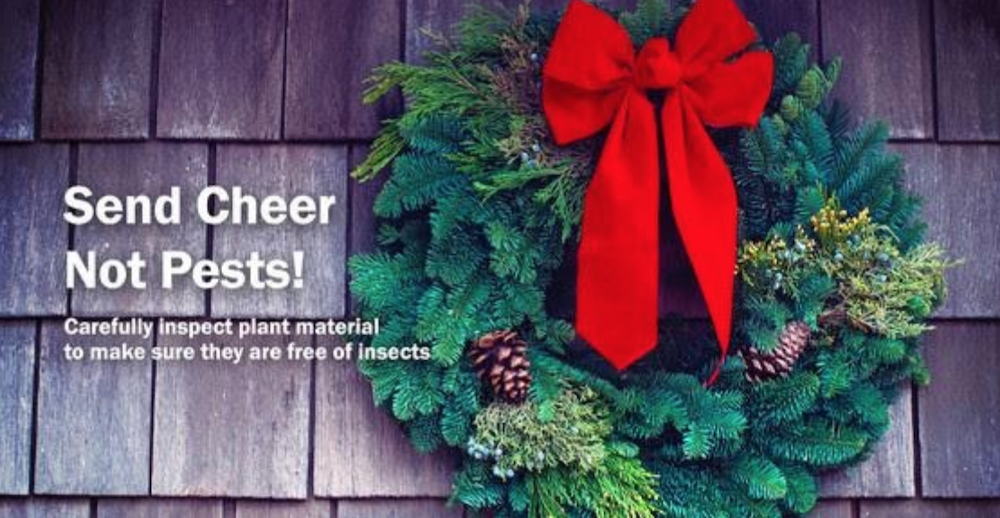
Maine residents cherish their holiday traditions, and for many, Maine-grown wreaths, trees, and decorative flora are a beloved part of the season. Another annual tradition is shipping festive greenery to friends and family. The Maine Department of Agriculture, Conservation, and Forestry (DACF) emphasizes the importance of adhering to state laws and regulations to ensure the seamless transport of healthy plant materials, ultimately saving time, cutting costs, and preventing product loss.
“Shippers should be aware of the state laws and regulations regarding the movement of plants and forest products,” noted Carole Neil, Assistant Horticulturist with DACF. “Many states closely monitor shipments to prevent the introduction of invasive insects and plant diseases. By planning, Maine shippers can speed up deliveries in this time-sensitive industry.”
DACF offers this advice for wreath and tree shippers:
- Import regulations vary from state to state. Check regulations in the destination state before you send plant material, and be aware that regulations may change from year to year. For example, Wisconsin implemented an elongate hemlock scale quarantine this year and shipments from some parts of Maine are no longer allowed. A summary of plant health regulations for Maine-grown holiday decorations on the Shipping Christmas Wreaths and Trees page (Maine DACF).
- Shipping internationally? Many countries prohibit most types of plant material in holiday decorations. Some may allow certain materials with the proper certification. Email horticulture@maine.gov for more information.
- Beware of invasive plants! Asiatic bittersweet and multiflora roses have pretty, decorative berries, but both are invasive and should not be included in holiday décor. Better choices with colorful berries include winterberry and holly.
- Look for pests. Carefully inspect plant material before packaging to ensure there are no insects, egg masses, or signs of pest damage.
- Clearly label packages. Begin with the statement “Grown in Maine,” followed by the county of origin and the shipper’s name and address. Labels should also specify the types of greenery, nuts, fruits, and cones used.
- Don’t forget about the spongy moth! Spongy moth (Lymantria dispar, formerly known as gypsy moth) certification is required when sending plant material outside the spongy moth quarantine area (Federal Spongy Moth Quarantine page (USDA). Contact the Maine USDA-PPQ office at 207.848.0000 for more information.
“Import requirements for cut trees and holiday decorations including greenery, ornamental nuts, and fruit exist to protect regional agriculture and natural resources from the risk of plant pests,” explained Sarah Scally, Assistant Horticulturist with DACF. “An insect or plant disease found in Maine could be invasive in other states. Unfortunately, despite the quality of Maine products, some shippers have learned about these regulations the hard way and have had shipments delayed, impounded, or destroyed. We want to prevent any losses by getting the word out now.”
Shippers with questions are invited to call 207.287.3891 or email horticulture@maine.gov.
Celebrating Collaboration and a Bright Future: The Journey of the Joyce Hedlund Community Garden at Eastern Maine Community College
By Liz True, Hancock County Master Gardener Volunteer and VP of Student Affairs at EMCC

Wendy Ault (MELMAC Foundation), President Emeritus Joyce Hedlund, Kim Lengert (Maine Ending Hunger Corps), Liz True, VP for Student Affairs EMCC, and Cathy Ryder (EMCC Americorps VISTA) at the Hedlund Community Garden dedication.
How many volunteers, agencies, and grants does it take to bring a campus community garden to fruition? Americorps VISTA member Cathy Ryder (EMCC ’22) knows. She had a dream of creating a community garden on the campus of Eastern Maine Community College in Bangor to supplement the college food pantry with fresh vegetables and herbs. Cathy’s VISTA position is part of the Maine Department of Agriculture’s Ending Hunger Corps. When Liz True, VP of Student Affairs at EMCC, learned of a grant opportunity with the MELMAC Foundation to support student retention, she, Cathy, and Mike Schwabenbauer, Director of EMCC’s federal TRIO program, wrote a proposal to fund the garden and support Cathy’s efforts to educate the community about strategies to end hunger. The goal was to lessen the impact of food insecurity among EMCC students who might have to prioritize work over their studies to feed their families.
The MELMAC grant provided funds to purchase all the garden supplies, from gopher-secure fencing to raised beds to seeds, as well as wages for student workers in the garden and food pantry. Kate Garland with the University of Maine Cooperative Extension offered tips on purchasing soil and selecting a site. Faculty and staff volunteers constructed the raised beds and learned the “lasagna” method of layering soil and compost.
The garden is sited prominently on campus, where everyone can admire the lush produce. Children in the on-campus Penquis Early Childhood Center visit the garden on their walks. A special bed was created just for them, with herbs and produce that appeal to children’s tastes.
The garden produced a bumper crop of tomatoes, herbs, greens, cucumbers, and peppers. The Cucurbitaceae varieties succumbed to powdery mildew, but the rest of the garden thrived. Volunteers were still harvesting Swiss chard and Brussels sprouts in late October. Planning is underway for next year’s garden. A focus group of food pantry clients suggested new crops and herbs that would help new Maine students create familiar meals.
The grant also funded educational programming about food insecurity, nutrition, thrifty shopping, and access to state programs. Cathy Ryder hosts weekly programs ranging from “How to Compost” to “Eating Healthy on Campus.” Another educational experience was a fall hunger banquet that raised funds to support the food pantry. Participants were divided into three groups based on Maine economic statistics: one small group enjoyed a three-course meal served by waitstaff, a larger group had pasta and salad, and the group representing those with food insecurity had mac and cheese and water. Kim Lengert, manager of Maine’s Ending Hunger Corps, provided statistics about food insecurity in Maine.
The initiatives funded by the grant have reaped significant rewards to date: the number of students served by the food pantry jumped from 178 in 2022 to 399 so far in 2023. Over 25 students have volunteered or worked in the garden. While one student brought her expertise as a graduate of the Stockbridge School of Agriculture, most of the student volunteers had never gardened before.
The Joyce Hedlund Community Garden at EMCC, dedicated to avid gardener and President Emeritus Hedlund, is an approved Master Gardener Volunteer project, and volunteers are especially needed in summer when fewer students are available. For more info, contact etrue@emcc.edu.
Backyard Bird of the Month – American Robin
By Maine Audubon Field Naturalist Andy Kapinos

The American Robin, or kwikweskas in Abenaki, is one of the most widespread and beloved backyard birds in North America. They are often easiest to locate by their sputtering calls, from which their onomatopoeic Abenaki name is derived. While these large, charismatic songbirds are heralded as a sign of spring when they flock to lawns in search of worms in the freshly thawed soil, they are also undeniably a sign of fall, when their massive flocks seem to pinball back and forth across the sky. These roving flocks move between abundant food sources and roosting sites throughout the nonbreeding season and rely on hardy fruiting trees and shrubs, like Winterberry and crabapples. Despite robins being so widespread and well-known, the full dynamics of their seasonal movements are not well understood. It is likely that many robins that breed farther north migrate through Maine to the Southeast, while some that breed here move seasonally but do not migrate long distances. According to National Audubon’s Bird Migration Explorer, American Robins encountered in Maine have been re-encountered in Quebec, around Chesapeake Bay, and in coastal Carolina. While we don’t entirely understand their movements, we do know that this behavior is innate: juveniles who were hand-reared in captivity began to exhibit restlessness at dusk around 14 days old!
For more on the importance of Maine native plants to support birds like the American Robin and other wildlife, visit Maine Audubon’s “Bringing Nature Home” webpage.
Gifts for the Gardener
Adapted from a December 2021 article written by Kate Garland, Horticulturist
Maybe you’re shopping for a gardening friend or your family is asking you what you wish for this year. Here’s a list of useful items any gardener would appreciate. Plus, this list puts you ahead of the pack when it comes to gathering your own supplies for the season ahead. Items noted with an asterisk were suggested by Maine Home Garden News readers in response to last month’s survey.
Links have been added to items that might not be familiar to all. Any links to commercial websites are not intended to be an endorsement of a specific product or company.
Hand Tools
- Pruners*
- Trimming snips*
- Loppers*
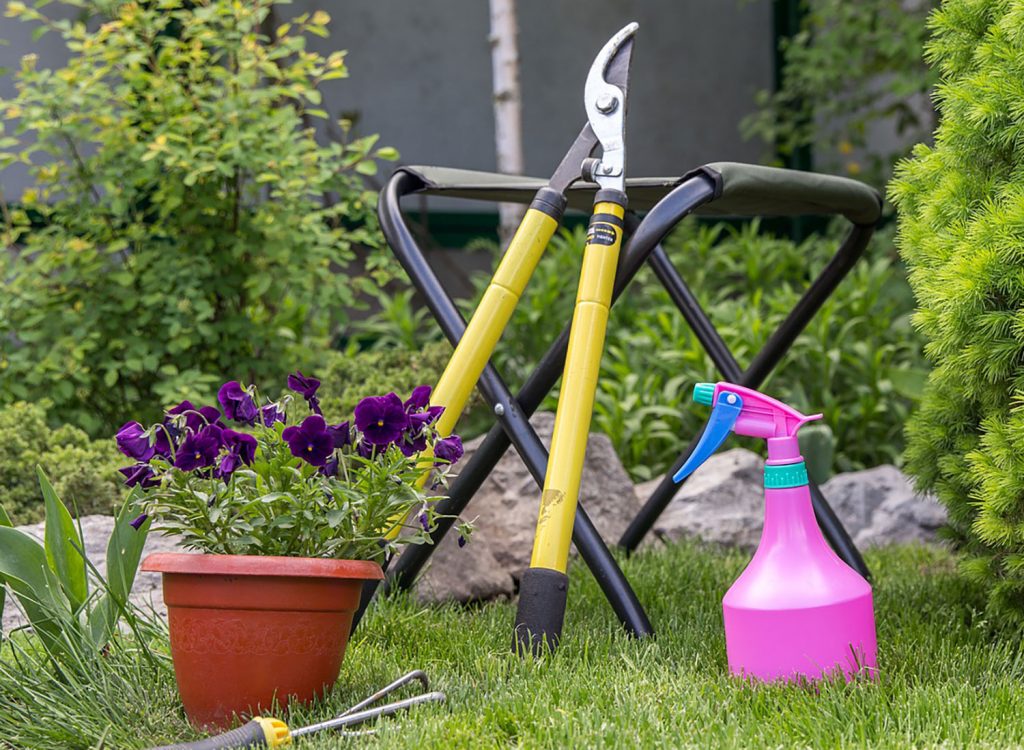 Pruning saw*
Pruning saw*- Hori Hori* or Ho-Mi
- Bulb planter*
- Root slayer shovel*
- Tool sharpening*
- Garden tool storage box or tote*
Togs
- Gloves*
- Hat*
- Knee pads*
- Overalls*
- Tool belt or holster
- Gardener’s Vest*
Seed Starting Supplies
- Seeds*
- Gift card from your favorite seed catalog
- Fertilizer*
- Seed starting mix*
- Soil blocker
- Heat mat
- Grow light*
Winter Activities
- Bird house
- Indoor plant stand
- Houseplant
- Bulbs for forcing
- Potted amaryllis
- Indoor herb kit*
- Garden magazine subscription*
- Books, books, and more books!
Summer supplies
- Certificate for a load of good compost
- Gift card for a local nursery
- A selection of perennial divisions from your own garden (be sure to read through “Best Practices for Donors” before sharing)
- Gift certificate for your time helping in the garden
- Row cover and hoops
- Harvest tub
- Potting soil*
- Mason jars and lids for canning
- Handmade plant labels
- Grow bags*
- Peony supports*
- Slug bait*
While some of these suggestions may seem a little TOO practical, just imagine the laughs you could get when your loved one unwraps a big bag of potting mix.
Maine Weather and Climate Overview (December)
Dr. Sean Birkel, Assistant Extension Professor, Maine State Climatologist, Climate Change Institute, Cooperative Extension University of Maine. For questions about climate and weather, please contact the Maine Climate Office.
Fall recap: Maine’s statewide average monthly temperature in October 2023 ranks 2nd warmest, just shy of 2017, for the 1895-present record period. However, the average minimum temperature for October 2023 ranks 1st warmest, related to unusually high overnight low temperatures. The first frost was generally observed 1–3 weeks later compared to fall 2017. October precipitation was above normal, rounding off a very wet growing season. Based on station data ending on the 26th, November 2023 has so far brought slightly below normal temperature and below normal precipitation. However, a storm on the 27th has brought warmth and precipitation (rain to the south, snow to the north) that will nudge the monthly values a little. For those interested, the finalized NOAA statewide and climate division temperature and precipitation data for November and the September–October–November fall season should be available on the Maine Climate Office website by Saturday, December 9th.
Looking forward, the NOAA Climate Prediction Center 6–10 day outlook probability maps for December 2–6 (issued November 26) show leaning above normal temperature and above normal precipitation for Maine. The 8–14 day and Week 3–4 outlook products suggest above normal temperature, but less certainty on precipitation. NOAA predicts moderate to strong El Niño conditions to continue over the next several months. In Maine, El Niño tends to bring warmer-than-normal temperatures, especially for strong events such as during the winters of 1997/98, 2009/10, and 2015/16. NOAA climate outlook maps are available on the Maine Climate Office website. And be sure to check weather.gov for the latest weather forecasts in your area.
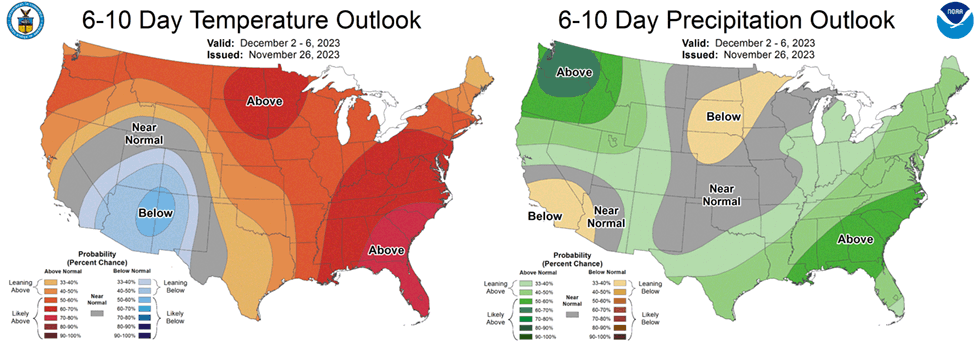
Special Thanks!
We are grateful for the following volunteers and staff who contributed to the Maine Home Garden Newsletter this year:
- Abby Zelz
- Abi Griffith
- Alicyn Smart
- Andy Kapinos
- Annika Schmidt
- Barbara Harrity
- Catherine Spolarich
- Charles Armstrong
- Christina Lannan
- Clara Ross
- Doug Hitchcox
- Expanded Food and Nutrition Education Program Staff (UMaine Extension)
- Ginger Laurits
- Janet Sherman
- Jonathan Foster
- Liz Stanley
- Liz True
- Lynne Holland
- Maine Department of Agriculture, Conservation, and Forestry Staff
- Mary Michaud
- Melissa Kim
- Michelle Snowden
- Naomi Jacobs
- Phoebe Call
- Rebecca Long
- Rebecca Sideman
- Rob Dumas
- Robin Betterley
- Ruby Bonilla
- Sean Birkel
- Shelby Hartin
- Wendy Robertson
- Zabet NeuCollins
Do you appreciate the work we are doing?
Consider making a contribution to the Maine Master Gardener Development Fund. Your dollars will support and expand Master Gardener Volunteer community outreach across Maine.
Your feedback is important to us!
We appreciate your feedback and ideas for future Maine Home Garden News topics. We look forward to sharing new information and inspiration in future issues.
Subscribe to Maine Home Garden News
Let us know if you would like to be notified when new issues are posted. To receive e-mail notifications, click on the Subscribe button below.
University of Maine Cooperative Extension’s Maine Home Garden News is designed to equip home gardeners with practical, timely information.
For more information or questions, contact Kate Garland at katherine.garland@maine.edu or 1.800.287.1485 (in Maine).
Visit our Archives to see past issues.
Maine Home Garden News was created in response to a continued increase in requests for information on gardening and includes timely and seasonal tips, as well as research-based articles on all aspects of gardening. Articles are written by UMaine Extension specialists, educators, and horticulture professionals, as well as Master Gardener Volunteers from around Maine. The following staff and volunteer team take great care editing content, designing the web and email platforms, maintaining email lists, and getting hard copies mailed to those who don’t have access to the internet: Abby Zelz*, Annika Schmidt*, Barbara Harrity*, Kate Garland, Mary Michaud, Michelle Snowden, Naomi Jacobs*, Phoebe Call*, and Wendy Roberston.
*Master Gardener Volunteers
Information in this publication is provided purely for educational purposes. No responsibility is assumed for any problems associated with the use of products or services mentioned. No endorsement of products or companies is intended, nor is criticism of unnamed products or companies implied.
© 2023
Call 800.287.0274 (in Maine), or 207.581.3188, for information on publications and program offerings from University of Maine Cooperative Extension, or visit extension.umaine.edu.

